Coronavirus: how different countries supported the unemployed
A comparison of the policies adopted by a collection of advanced economies with different tax and benefit systems.
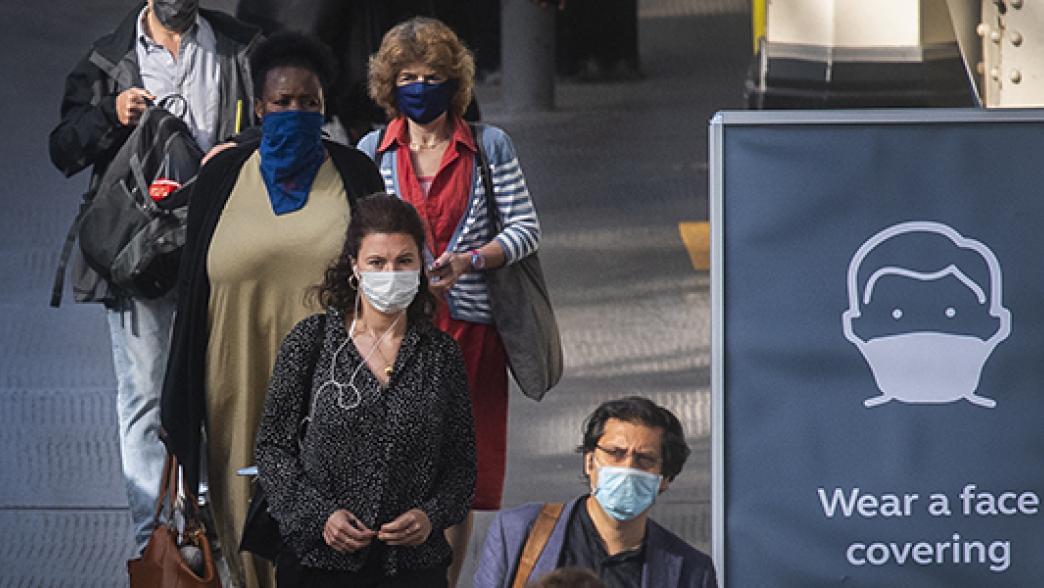
The coronavirus crisis led to big increases in unemployment in most developed countries as businesses were forced to shut and workplaces had to adjust to social distancing requirements. In response, some governments attempted to safeguard jobs by subsidising workers’ wages. Most countries also changed the support available for those who lost work (or were already not in work) during the pandemic .
What type of changes did countries make to unemployment support?
This explainer lays out the policies adopted by seven advanced economies that have different social security systems in normal times. Most of the countries we look at here temporarily increased the provision for those not in work – a group which increased in every country – by increasing the size of payments or making more people eligible for unemployment benefits.
However, the approaches between the countries surveyed here differed. France and Germany made the smallest changes to the provision for the unemployed. Their existing system was already relatively generous for average and higher earners, and the only changes were to extend eligibility to these benefits. In France, the period of time that someone could claim enhanced benefits related to their salary was extended. In Germany, the requirements to access basic subsistence support were relaxed.
In the UK, eligibility to Universal Credit was not changed, but the generosity was increased by a relatively modest (by international comparison) increase of £20 per week. This still left the UK system as one of the least generous, especially for those who previously had higher earnings.
In the US and Australia, large temporary supplements to unemployment insurance were announced of $600 per week (£440 per week*) and AUS$550 per fortnight (£150 per week) respectively. As well as applying to those that would ordinarily receive unemployment benefits, the new payment was also available more widely. In Australia, the supplement also applied to benefits for younger workers and parents. In the US, the payment was also made available to care givers, the self-employed, and those whose access to unemployment benefits had otherwise expired.
Canada and Ireland both introduced entirely new benefits that applied both to those receiving ordinary unemployment benefits and more broadly, including to the self-employed and to care givers.
The chart shows the impact of the pandemic additions to benefits on the income of an unemployed person that was previously working on the minimum wage. The biggest increase in generosity was in the US, where a person claiming pandemic-related unemployment support would earn more than a full-time worker on the minimum wage. The generosity did not change in France and Germany, leading to the lowest unemployment replacement rates for minimum wage workers of the countries surveyed here, once pandemic changes are taken into account. The £20 a week uplift to Universal Credit made UK unemployment roughly equal to its continental counterparts.
* All currency conversions based on market rates on 5 January 2022 and rounded to nearest £10.
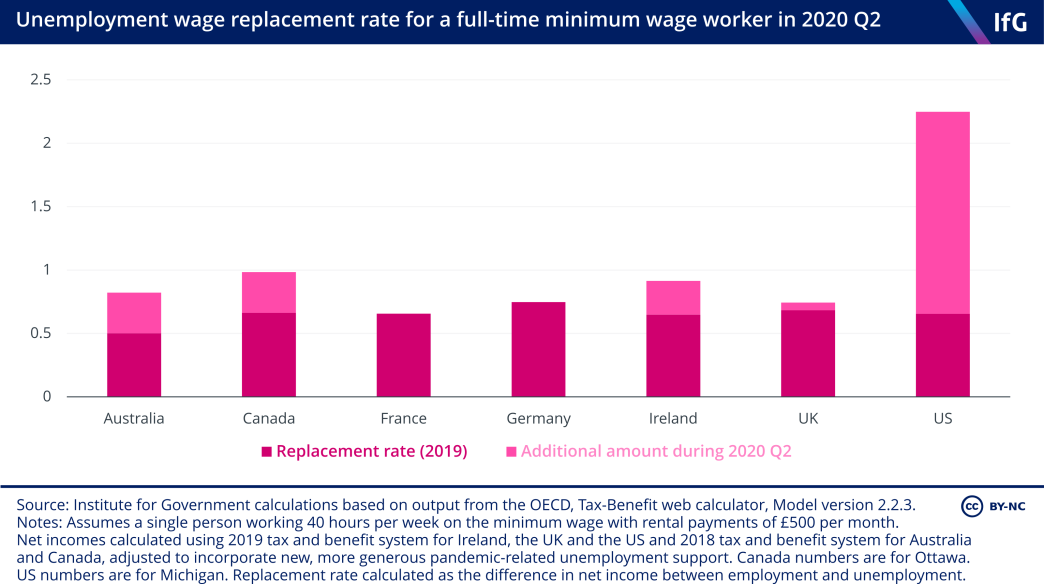
How did unemployment support change through the crisis?
As the severity of the pandemic has fluctuated since March 2020, countries have modified their economic support packages. In most cases, this has involved continuing programmes designed to help the unemployed beyond their initial termination dates, as the crisis has continued for longer than originally envisaged. Every country analysed here extended the temporary aspect of support beyond the original planned end date.
While the support has been extended, in some countries the generosity of the schemes was reduced as the severity of the pandemic and its economic impact declined. For example, in Australia the initial AUS$550 per fortnight became AUS$250 per fortnight (£70 per week) in September 2020 and $150 per fortnight (£40 per week) in January 2021. Likewise, in the US additional unemployment assistance was restarted in December 2020 (after being suspended in July), but at a generosity of only US $300 per week (£220 per week) rather than US$600.
How did the number of people claiming unemployment support change during the crisis?
In all countries analysed here, claims for unemployment benefits increased in the second quarter of 2020 at the onset of the crisis. Claims increased more quickly in countries that did not also have effective wage support. The charts below show how the use of claims (as a share of the labour force) changed in the different countries, except Canada which shows applications for special pandemic benefits as a proportion of the labour force.
Australia
The number of people on JobSeeker – the main unemployment benefit – and other related benefits almost doubled from 6% to 12% of the labour force. It has fallen steadily since but remained above pre-crisis levels in August 2021.
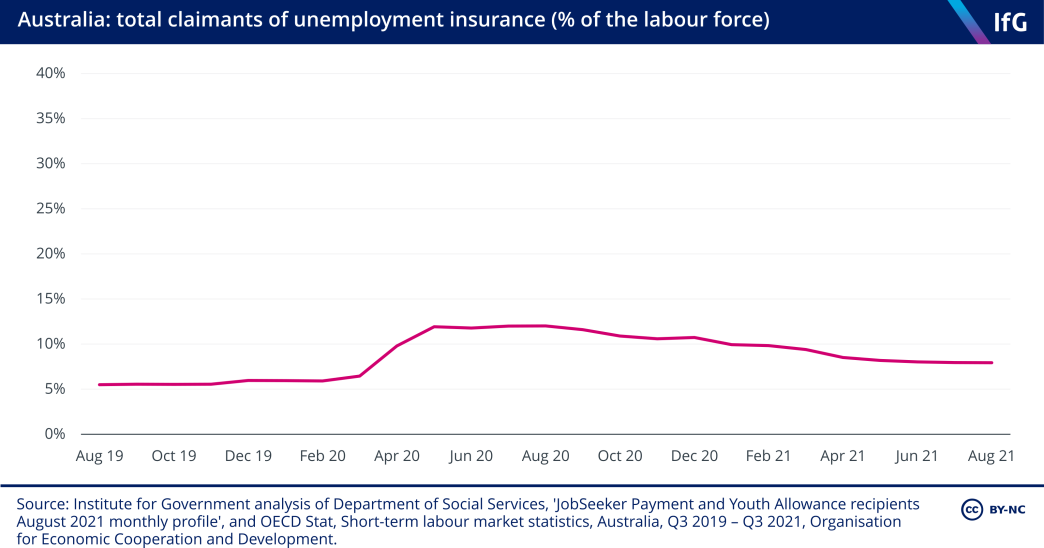
Canada
The chart below looks at claimants for regular employment insurance and the special Covid-related schemes (the Canadian Emergency Response Benefit (CERB) from April to September 2020 and the Canadian Recovery Benefit (CRB) from October 2020 to October 2021). Usage of CERB was very high initially and over one-third of the workforce was relying on these benefits at the peak in April. It then fell quickly but remains far above pre-crisis levels.
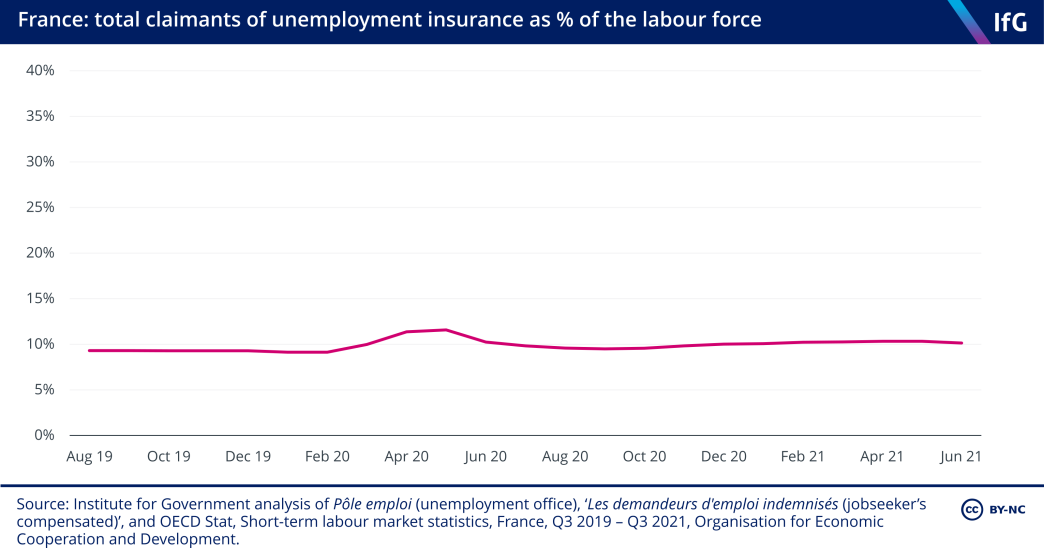
France
The chart below looks at claimants of Assurance chomage (unemployment insurance). Going into the crisis, France was an outlier with a relatively high proportion of the labour force on unemployment benefits. It increased a little, although not substantially, at the onset of the crisis but quickly fell back towards pre-crisis levels.
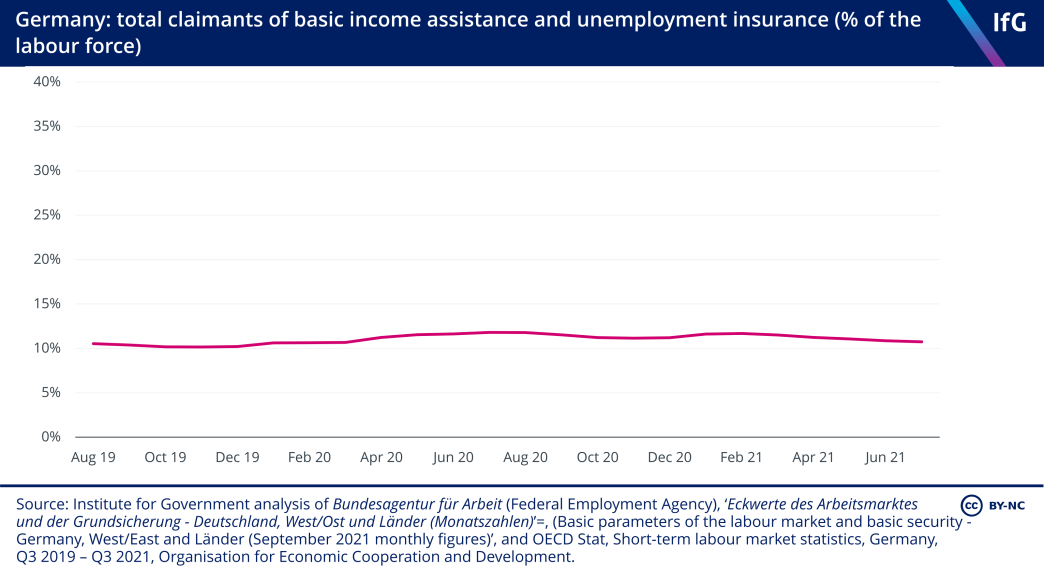
Germany
Claims for Germany’s two types of unemployment support (for those eligible for support through the unemployment insurance system and those not) increased when public health restrictions increased in Germany, but only modestly.
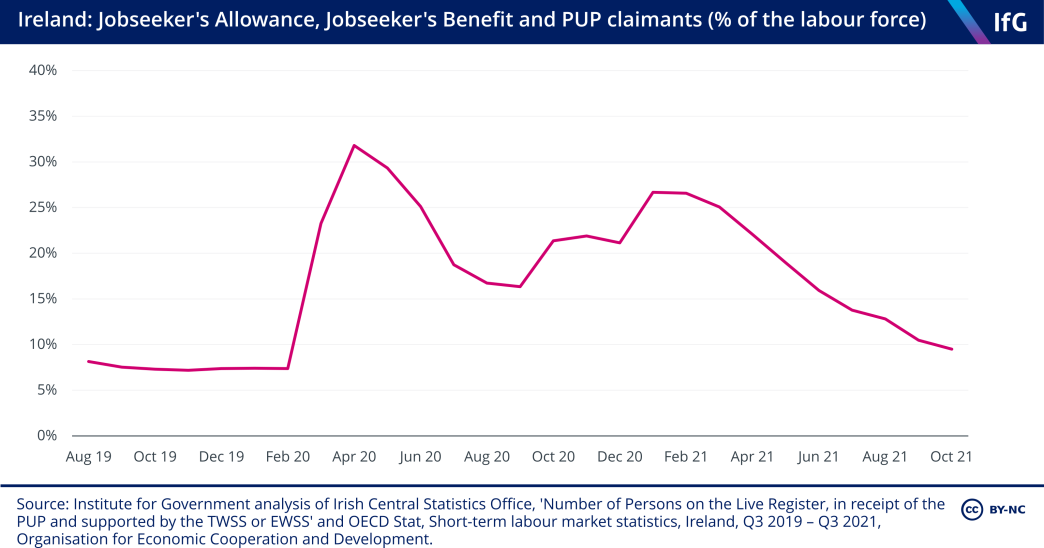
Ireland
The relative generosity of Ireland’s pandemic unemployment payment (PUP) led to high take-up of the new benefit when it was introduced. Almost one-third of the labour force relied on the benefit initially. This fell quickly, but benefit claims remained above pre-crisis levels.
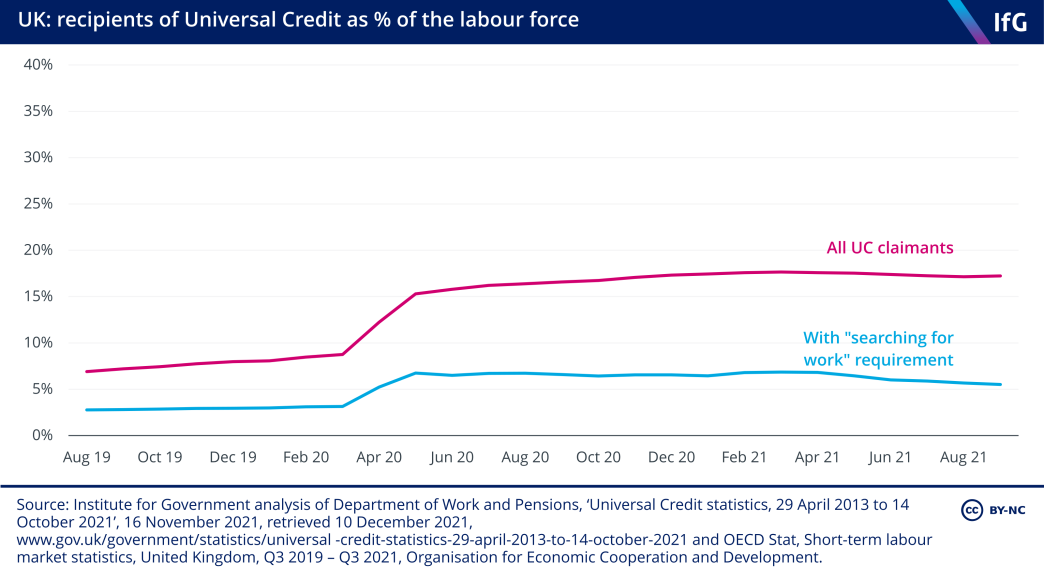
UK
Claims for Universal Credit in the UK jumped more quickly than official unemployment statistics in the UK, and remains far above pre-crisis levels. This is true whether all claimants or included, or only those not in work.
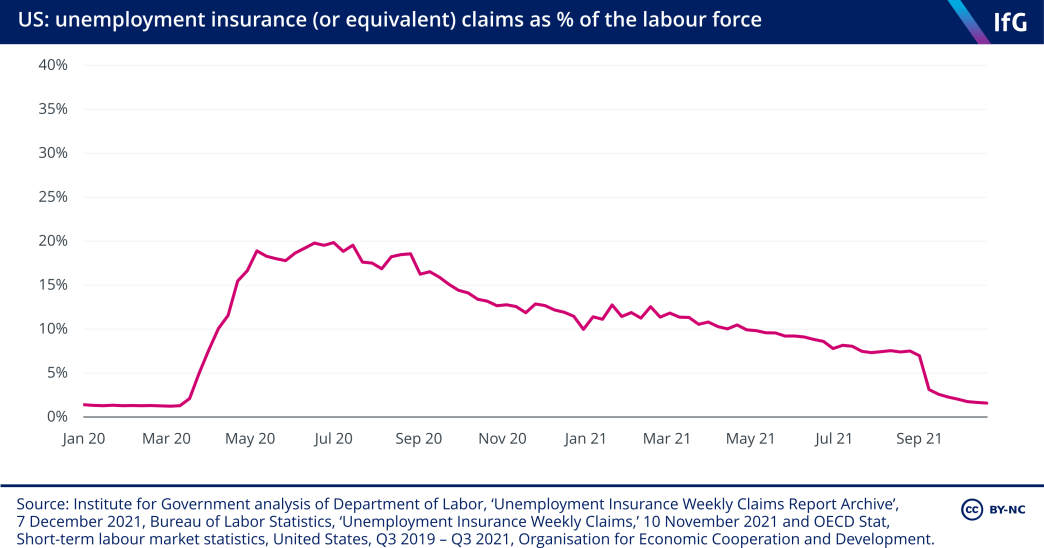
US
The increase in benefit claims in the US is behind only those in Ireland and Canada initially. Almost 20% of the workforce were claiming unemployment insurance at one point in 2020. As the economy has recovered, the numbers claiming have fallen. Although the data only runs up to the end of October 2021, a sharp drop off in UI claimants is clear from the chart as federal government funding for pandemic unemployment support was withdrawn.
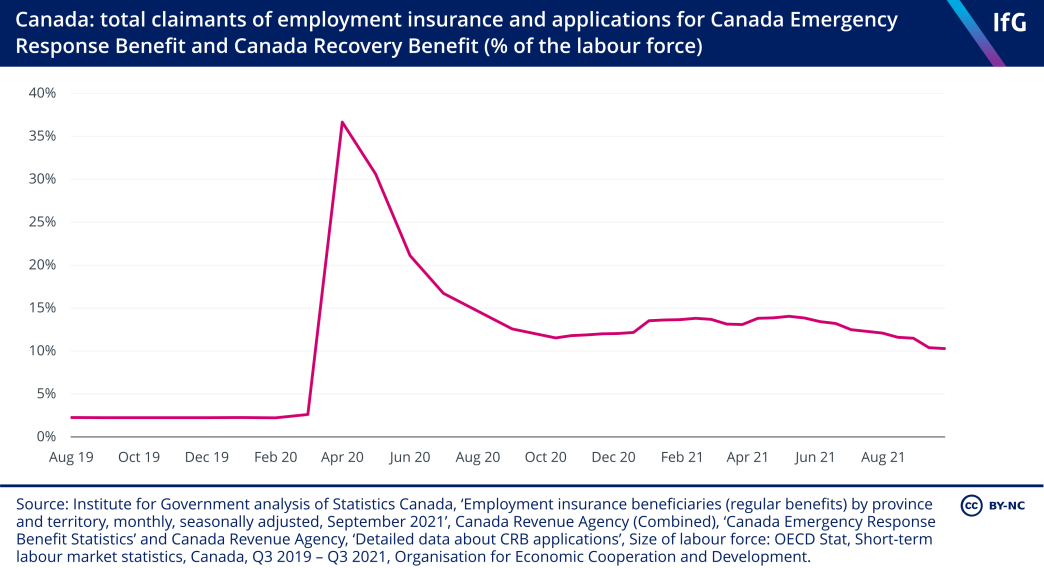
When did support stop?
All the countries surveyed here which introduced new unemployment benefits ended these programmes by autumn 2021, except Canada. Australia’s coronavirus supplement to JobSeeker ended on 31 March; Ireland’s PUP initially closed to new applicants on 7 July (although payments will continue until 25 March 2022); US federal government funding for pandemic unemployment support ended on 4 September; the temporary increase in UC in the UK expired at the start of October 2021. Although the Canada Recovery Benefit ended on 23 October, this programme was replaced with the Canada Worker Lockdown Benefit, which provides a CAN$300 (£170) weekly payment for workers affected by provincial public health restrictions and is due to last until May 2022. Of the countries which didn’t introduce new benefits, France’s unemployment insurance reverted to usual terms from July 2021 and the changes to basic income support in Germany will end on 31 December 2022.
In most cases, the support available to the unemployed then reverted to a similar level as before the pandemic. A notable exception is Australia, where unemployment benefits were permanently increased by AUS$50 per fortnight (£10 per week) in March 2021. In the UK, the generosity of Universal Credit has been increased since the temporary £20 per week uplift ended, but only for those in work.
Has support returned to deal with new variants, such as Omicron?
As the Omicron wave has spread around the world, some countries have reintroduced public health restrictions. So far, Ireland and Canada are the only countries of those we analyse here to have bolstered support for the unemployed. In Ireland, applications to the PUP reopened between 7 December 2021 and 22 January 2022 following the closure of nightclubs and capacity restrictions on indoor events such as concerts. In Canada, the Canada Worker Lockdown Benefit was opened up to businesses suffering from capacity restrictions (as well as full local lockdowns) between 22 December 2021 and 12 March 2022.
Country |
Change made at start of pandemic |
Did the scheme change during the pandemic? |
How was the programme extended beyond its original end date? |
Due date of expiry/date programme ended |
|---|---|---|---|---|
|
UK |
£20 a week uplift in Universal Credit (UC) and Working Tax Credits (WTC) |
No. |
Universal Credit uplift introduced in March 2020 originally for one year; extended for a further six months in April 2021. | 6 October 2021 |
|
Australia |
Coronavirus supplement: additional AUS$550 per fortnight (£150 per week) for jobseeker claimants |
Fortnightly coronavirus supplement reduced to AUS$250 for Sep-Dec 2020 (£70 per week) and then AUS$150 for Jan-Mar (£40 per week). Permanent increase in jobseeker of AU$50 a fortnight from April 2021 (£10 per week). |
Initially for six months; extended for two more three month periods, with reducing eligibility. | 31 March 2021 |
|
Canada |
Canadian Emergency Response Benefit (CERB): CAN$500 (£290) a week for people who lost their job or had their hours reduced. |
CERB ended on 26 September 2020 and was replaced by several new benefits, including the CAN$500 (£290) a week Canadian Recovery Benefit (CRB) to support workers who were ineligible for unemployment insurance. CRB replaced with CAN$300 (£170) a week Canada Worker Lockdown Benefit for workers who cannot work due to local public health restrictions on 24 October 2021. |
CERB completed within the original timeframe; CRB was extended in July until the end of October; Canada Worker Lockdown Benefit retroactively applied from 23 October 2021 and scheduled to last until May 2022. |
23 October 2021 (CRB) 7 May 2022 (CWLB) |
|
France |
Time on unemployment insurance during the pandemic would not count towards overall limits on how long you can claim for. |
No change. |
Initially the changes were only due to last until the end of May. It was extended several times and finally ended in June 2021. |
Time on unemployment insurance counted as normal from July 2021. |
|
Germany |
Eligibility for basic income support for the previously self-employed was eased: self-employed could claim basic income support if they didn’t have any orders/business forthcoming – normally claimants have to be searching for work. |
One-off payment of €150 (£130) made to solo-self-employed in the basic income support scheme in May 2021. |
Changes to basic income support were initially for six months and then extended in summer 2020 to the end of December. Further extensions to 31 March and 31 December 2021 and 31 December 2022 were announced in November 2020 March 2021 and February 2022 respectively |
31 December 2022 |
|
Ireland |
Pandemic unemployment payment (PUP): €350 (£300) per week benefit for employees and self-employed workers |
Different rates for claimants were introduced, depending on previous wages, on 29 June, 17 September, and 16 October 2020. |
Initially introduced for a 12 week period; then extended 3 times (to August 2020, then April 2021 and then to July 2021). |
Closed to new applicants on 7 July 2021; existing claimants moved onto standard jobseeker by 25 March 2022. Applications reopened 7 December 2021 – 22 January 2022 in response to Omicron variant. |
|
US |
Pandemic Unemployment Assistance (PUA): support to those not covered by unemployment insurance, varies by state Pandemic Emergency Unemployment Compensation (PEUC): federal government funded continued access to state unemployment programs beyond usual claimant period Federal Pandemic Unemployment Compensation (FPUC): extra $600 (£440) weekly payment on top of the other programmes, including PUA and PEUC |
FPUC decreased to $300 (£220) per week 27 December 2020 – 4 September 2021. |
The December 2020 stimulus package extended the PUA and PEUC programs (which had been due to expire then) and restarted FPUC (which expired in July 2020), initially until April 2021. | 4 September 2021 (PUA, PEUC and FPUC programs in all states) |
Sources:
- UK: https://lordslibrary.parliament.uk/universal-credit-an-end-to-the-uplift/#:~:text=An%20uplift%20On%2020%20March%202020%2C%20the%20Chancellor,by%20%C2%A31%2C000%20a%20year%2C%20or%20%C2%A320%20a%20week.
- Australia:https://treasury.gov.au/sites/default/files/2020-07/Fact_sheet-Income_Support_for_Individuals.pdf; www.abc.net.au/news/2021-03-18/how-much-is-jobseeker-when-does-it-end-what-are-new-rules/13259460
- Canada: www.canada.ca/en/services/benefits/ei/cerb-application.html; www.canada.ca/en/department-finance/news/2021/12/government-temporarily-expands-access-to-lockdown-program-and-worker-lockdown-benefit.html; www.canada.ca/en/department-finance/news/2022/02/government-extends-expanded-access-to-local-lockdown-program-and-worker-lockdown-benefit.html
- France: www.unedic.org/indemnisation/vos-questions-sur-indemnisation-assurance-chomage/comment-est-calculee-mon-allocation-chomage;
- Germany: https://static.eurofound.europa.eu/covid19db/cases/DE-2020-13_404.html; www.bundesfinanzministerium.de/Web/EN/Issues/Public-Finances/stimulus-package-for-everyone/stimulus-package-for-everyone.html; www.bmas.de/DE/Service/Presse/Pressemitteilungen/2022/vereinfachter-zugang-zur-grundsicherung-wird-verlaengert.html
- Ireland: www.gov.ie/en/service/be74d3-covid-19-pandemic-unemployment-payment/#rate-of-payment; www.gov.ie/en/service/be74d3-covid-19-pandemic-unemployment-payment/#how-to-qualify; www.gov.ie/en/publication/0b0fc-covid-19-pandemic-unemployment-payment-rates/#rates-from-9-november-2021
- US: https://tcf.org/content/report/unemployment-insurance-data-dashboard/?agreed=1; https://des.nc.gov/need-help/covid-19-information/covid-19-information-individuals/pandemic-emergency-unemployment#how-much-will-i-be-paid-for-peuc; https://des.nc.gov/need-help/covid-19-information/covid-19-information-individuals/federal-pandemic-unemployment
- Topic
- Coronavirus
- Country (international)
- France Germany United States
- Publisher
- Institute for Government